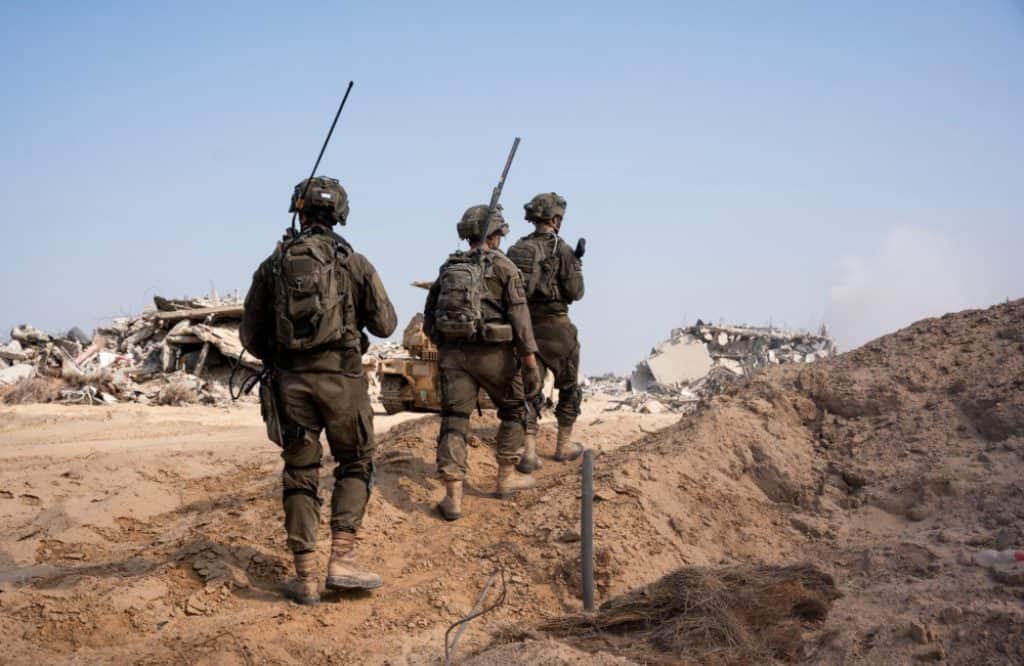
On November 10, Israeli troops inspecting a convoy of trucks moving between southern and northern Gaza uncovered a bag containing small-arms ammunition. The discovery highlights some of the IDF’s challenges as it seeks to increase humanitarian aid to civilians and expand a humanitarian area.
The convoy in which ammunition was found was part of a group of vehicles traveling from southern Gaza to northern Gaza, crossing the Netzarim Corridor controlled by the IDF. “IDF troops apprehended those involved, including members of the convoy, who were then transferred to security forces for further investigation. Inquiries were also made with the relevant organization,” the IDF said. This statement indicates that an unnamed international organization was involved with the convoy. “During the passage of a convoy coordinated with the international community and monitored by the IDF, unusual movement was detected,” the Israeli military said.
Israeli leaders are weighing several tasks in Gaza in November. The IDF is beginning to wrap up more than a month of operations in Jabaliya in northern Gaza, but terrorists remain in the area. “Over the past day, the troops eliminated dozens of terrorists and dismantled many terror infrastructure sites, as well as a weapons storage facility in the area,” the IDF said. In neighboring Beit Lahia, Israeli troops also eliminated dozens of terrorists, according to a statement by the military. “They also located weaponry and a tunnel shaft in the area.”
The battles continue to take their toll on the IDF. Two soldiers in the 401st Armored Brigade were severely injured in combat on November 10. A squad commander in Israel’s elite Lotar counter-terrorism unit, Major Itamar Levin Fridman, was also killed, the IDF announced on November 11.
In Rafah in southern Gaza, the IDF also continues to find terrorists and weapons. The sweeps for enemy fighters along and near the Philadelphia Corridor, which parallels the Egyptian border, are now being done by the IDF’s Gaza Division, with the Nahal Brigade having been placed under it temporarily for these tasks. The unit has conducted raids in and around Rafah to keep Hamas from returning. “During these raids, the soldiers eliminated many terrorists,” the IDF said. In one neighborhood, soldiers found weapons and ammunition stockpiles that were left behind by terrorist groups. “In one of the searches near a mosque and a hospital, a weapons storage facility containing observation equipment, drones, enemy manufacturing supplies, explosive devices, and dozens of mortar shells was located,” the IDF said on November 9.
The Israeli military also announced that it was enabling an expansion of the Mawasi humanitarian area northwest of Rafah. This effort may be due to the influx of around 60,000 civilians who evacuated Jabaliya last month. Some evacuees ended up in southern Gaza.
Expanding the humanitarian area is also part of the IDF’s push for more aid to enter areas of Gaza. The Israeli military’s Coordination of Government Activities in the Territories (COGAT) has a Coordination and Liaison Administration (CLA) for Gaza and recently said that 11 trucks with food, water, and medical equipment entered Jabaliya and Beit Hanoun in northern Gaza. Many areas in Gaza’s north, such as around Beit Lahiya and the outlying regions of Jabaliya, appeared deserted when I visited them on November 5. However, the movement of the trucks indicates some civilians remain.
From October to mid-November, the IDF said that 713 aid trucks entered northern Gaza, including Gaza City and its environs. These trucks enter through the Erez West crossing. On November 5, I witnessed trucks preparing to enter this crossing and traveling back and forth with IDF supervision from the border to areas near Shati along the coast, where they evidently entered areas still controlled by Hamas.
On November 8, the IDF said it had been asked by Israel’s political leadership to increase the volume of aid and the number of aid routes entering Gaza. COGAT will now open another crossing at Kissufim near Khan Younis to prepare to move more aid. This route will enable humanitarian supplies to directly reach Khan Younis, the central camps area, and Mawasi.
Kissufim is an old Israeli crossing that was used as an access route for Israeli communities in Gaza before the 2005 disengagement from Gaza. These prior communities, such as Kfar Darom and the Katif settlements near the beach, are near where the central camps and Mawasi and Khan Younis are today. In essence, the old road that once accessed these areas will now be used for moving aid. The Kissufim region is also where the IDF staged units during the battle for Khan Younis between December 2023 and April 2024.
The IDF said the Kissufim crossing has been prepared for use by the Gaza Division’s engineering unit. “As part of the work, the forces built inspection facilities and protective infrastructure, and paved roads both in Israeli territory and within the Gaza Strip to allow the transfer of aid to the southern part of the Strip.” The intense use of IDF engineering units and their D-9 bulldozers has been one of the key aspects of the war. Recent reports in the Israeli media indicate that a shipment of more than 100 D-9s is being held up in the US.







